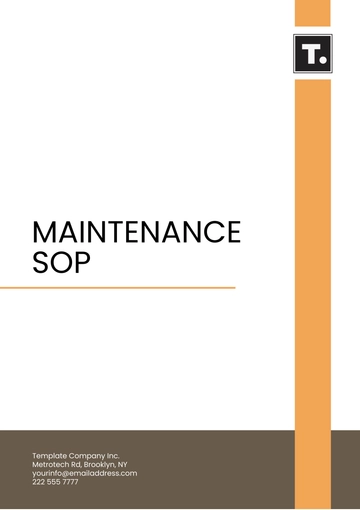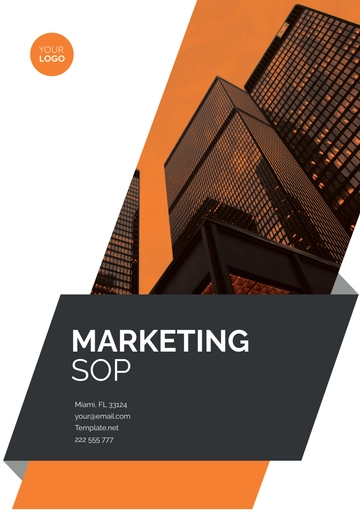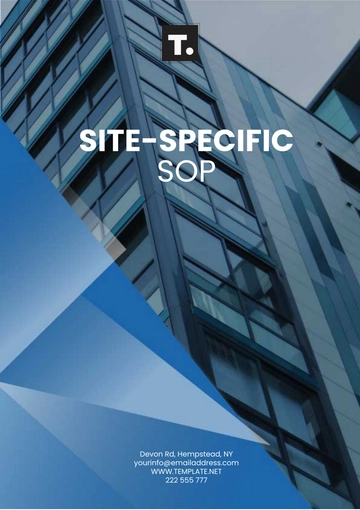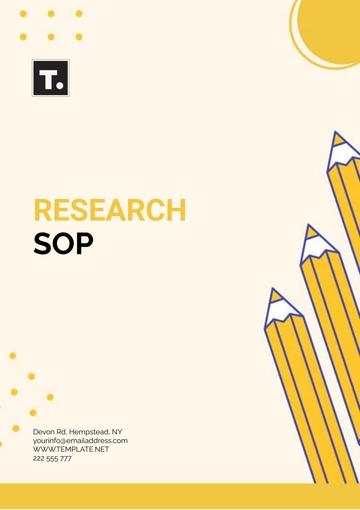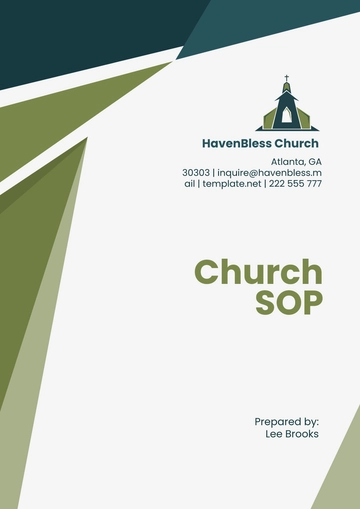Free Travel Agency SOP

1. Introduction
1.1 Purpose of the SOP
The purpose of this Standard Operating Procedures (SOP) document is to provide all employees of [Your Company Name] with clear and consistent instructions on routine operations and procedures. This SOP is designed to ensure that all team members are aligned with the company's standards of service and operational efficiency.
1.2 Scope
This SOP covers the following areas of operation within [Your Company Name]:
Client interaction and service
Travel planning and booking
Use of company technology and systems
Basic administrative and office procedures
1.3 Target Audience
This document is intended for use by:
Travel Consultants
Customer Service Representatives
Booking Agents
Marketing and Sales Teams
Administrative Staff
1.4 Definitions and Abbreviations
Term/Abbreviation | Definition |
|---|---|
SOP | Standard Operating Procedures |
CRM | Customer Relationship Management |
ETA | Estimated Time of Arrival |
ETD | Estimated Time of Departure |
2. Company Overview
2.1 History and Background
[Your Company Name] was founded in [Year] with the mission to provide tailored travel planning and exceptional travel experiences to clients worldwide. Starting as a small boutique agency, [Your Company Name] has grown into a respected leader in the travel industry, known for our personalized service and dedicated client care.
2.2 Vision and Mission
Vision: To be the leading travel agency in providing personalized, innovative, and sustainable travel experiences globally.
Mission: To empower clients to explore the world with ease and comfort, supported by our expertly crafted travel solutions and unwavering commitment to customer service.
2.3 Organizational Structure
Position | Responsibilities |
|---|---|
General Manager | Oversees all agency operations, strategic planning, and management. |
Travel Consultants | Handle inquiries, bookings, travel arrangements, and customer service. |
Marketing Director | Leads marketing initiatives and online presence. |
HR Manager | Manages recruitment, staff training, and HR policies. |
3. General Operating Procedures
3.1 Office Hours
[Your Company Name] operates from 9:00 AM to 5:00 PM, Monday through Friday. Special hours apply during public holidays and will be communicated via internal memo and posted on the company’s main entrance and website: [Your Company Website].
3.2 Communication Protocols
Internal Communication: Use the company email system for formal communications and instant messaging for informal updates.
External Communication: All client interactions should be conducted in a professional tone using either official emails or direct phone calls, adhering to privacy standards.
3.3 Client Data Management
Client information is to be stored in our secure CRM system. Access to this data is restricted to authorized personnel only. Regular backups are to be performed weekly.
3.4 Handling of Financial Transactions
All transactions must be recorded in the company’s accounting software. Receipts should be issued for every transaction and stored both digitally and physically for a period of 5 years.
3.5 Safety and Security Measures
Ensure the creation and maintenance of a secure environment by adhering strictly to the company’s established security protocols. This includes implementing secure log-in procedures for all operational systems and maintaining continuous CCTV surveillance to monitor the premises effectively.s.
4. Client Interaction Procedures
4.1 Client Onboarding Process
New clients are to be entered into the CRM system with all relevant details captured during the initial inquiry call. A welcome package is to be sent, outlining our services.
4.2 Booking Process
4.2.1 Flight Reservations
Please ensure that you book flights using the software approved by our company. Ensure to thoroughly verify all of the client's details and preferences to confirm that they are fully accommodated. Once the booking is complete, provide confirmation to the clients via email.
4.2.2 Hotel Bookings
It is essential to engage accommodations from vendors that have received official approval. Ensure that the preferences and budget of the client are prioritized throughout the booking process. Once these arrangements are finalized, promptly send the client all relevant confirmation and itinerary details.
4.2.3 Excursion Arrangements
Plan excursions based on client interests and safety guidelines. Confirm availability and book. Provide clients with a detailed itinerary.
4.3 Handling Client Inquiries
Ensure that all inquiries from clients are responded to within a 24-hour timeframe. Utilize the designated inquiry log sheet to accurately record, track, and manage all necessary follow-up actions with these clients.
4.4 Complaint Resolution Process
Ensure that all complaints are recorded systematically in the Customer Relationship Management system. It is imperative to follow up on each complaint within a 24-hour period. Endeavor to resolve these complaints within a 72-hour timeframe, and escalate issues of complexity to the management for further attention.
4.5 Follow-up and Feedback Collection
After the completion of the trip, distribute a feedback survey to participants. Following the collection of responses, conduct a thorough analysis of the feedback in order to enhance and improve the services offered.
5. Travel Planning and Management
5.1 Research and Itinerary Planning
Engage in extensive research utilizing reputable sources to carefully develop tailored travel itineraries. Take into account feedback from clients, specific details about the destination, and any relevant travel advisories.
5.2 Risk Assessment for Travel
Conduct a thorough assessment of the potential risks associated with each itinerary, taking into consideration various aspects such as health, safety, and security based on current advisories. Once these risks are identified, develop and implement appropriate strategies to mitigate them effectively.
5.3 Special Needs and Accessibility Accommodations
Determine the unique needs specific to each client and make certain that all travel arrangements are tailored to meet these requirements comprehensively and without any compromises.
5.4 Emergency Procedures During Travel
Ensure that clients are provided with contact numbers that are available at all hours, 24/7. It is crucial to establish a well-defined protocol for addressing travel emergencies, which should include specific procedures for managing medical issues, legal problems, and disruptions related to travel.
6. Use of Technology
6.1 Software for Booking and CRM
Booking Software: Use [Software Name] for all travel booking needs. This includes flights, hotels, and rental services. Training is provided to ensure proficiency.
CRM System: Use [CRM Software Name] to manage client relationships, store client data securely, and track all client interactions and transactions. Regular updates and backups are scheduled and managed by the IT department.
6.2 Data Security Protocols
Data Protection: Implement and maintain robust cybersecurity measures, including firewalls, anti-virus software, and encryption technologies.
Access Controls: Restrict access to sensitive information to authorized personnel only. Use role-based access controls in all systems.
Audit and Compliance: Conduct regular audits to ensure compliance with data protection laws and rectify any discrepancies immediately.
6.3 Online Marketing and Social Media Use
Social Media Guidelines: Maintain a professional tone across all platforms. Post regularly to engage with potential clients and promote offerings.
Email Marketing: Use email campaigns to reach out to potential and existing clients with offers, new packages, and newsletters. Ensure compliance with anti-spam laws.
Website Management: Keep the company website updated with the latest offers, travel advisories, and blogs to assist travelers. Ensure the website is user-friendly and SEO-optimized.
7. Staff Training and Development
7.1 Orientation for New Employees
New employees undergo a comprehensive orientation program that covers:
Company Culture and Ethics
SOP Training: Detailed walkthroughs of all standard operating procedures.
Role-Specific Training: Depending on position, including booking systems, customer service protocols, and emergency procedures.
7.2 Ongoing Training Programs
Skill Enhancement: Regularly scheduled workshops and seminars are designed to enhance a variety of skills, including customer service, sales techniques, and the use of technology.
Certifications: Foster an environment that encourages and supports staff members in their pursuit of obtaining certifications that are specific to their industry.
Performance Reviews: Carry out performance reviews twice a year to engage in discussions regarding achievements, identify areas that require improvement, and develop plans for career advancement.
7.3 Performance Evaluation and Feedback
Evaluation Criteria: Clearly defined metrics for evaluating employee performance including client feedback, sales targets, and operational efficiency.
Feedback Mechanism: Constructive feedback is delivered to individuals through a variety of methods including one-on-one meetings, comprehensive performance reviews, and detailed annual appraisals.
8. Quality Control and Improvement
8.1 Regular Audits and Evaluations
Internal Audits: Conduct internal audits quarterly to assess adherence to SOPs, legal regulations, and quality of service. Internal audits help identify areas for improvement and ensure compliance across all departments.
Audit Schedule:
Quarter | Departments | Focus Areas |
|---|---|---|
Q1 | Booking | Compliance, Efficiency |
Q2 | Operations | Safety, Client Data |
Q3 | Customer Service | Service Quality, Response Times |
Q4 | IT | Security, Software Updates |
External Audits: Annual audits performed by accredited external auditors. These provide an objective assessment of operational practices and compliance with industry standards.
8.2 Client Satisfaction Surveys
Survey Deployment: Implement a standardized survey system to gather feedback from clients after each service interaction or travel completion. This feedback is crucial for continuous improvement.
Survey Distribution Method:
Method | Description | Frequency |
|---|---|---|
Send surveys via email post-trip. | After each trip | |
Phone Call | Follow-up calls for detailed feedback | Monthly sampling |
Online Portal | Clients can provide feedback via the website | Ongoing |
Analysis and Reporting: Compile and analyze feedback quarterly to identify trends, issues, and opportunities for service enhancement. Adjust strategies and processes based on feedback to improve client satisfaction.
8.3 SOP Revision Process
Continuous Improvement: Establish a structured process for regularly reviewing and updating SOPs. Engage staff from all levels to provide feedback on procedural efficiencies and challenges.
Review Period | Departments Involved | Changes Proposed | Implementation Date |
|---|---|---|---|
Bi-annual | All Departments | Updates as per internal and client feedback | The following Quarter |
Update Mechanism: Include a systematic approach to implementing updates to the SOPs, with clear accountability and timelines for rollout.
9. Approval and Revision History
9.1 Document Approval
This section ensures that the SOP document is formally approved by the authorized personnel within the organization, highlighting accountability and endorsing the procedures outlined as the official protocol for operation.
Document Approval Process:
The final draft of the SOP must be reviewed and approved by the designated individuals listed below.
The approval signifies that the SOP complies with the company's standards and operational requirements.
Role | Name | Date |
|---|---|---|
General Manager | [Name] | [Date] |
Operations Manager | [Name] | [Date] |
HR Manager | [Name] | [Date] |
IT Manager | [Name] | [Date] |
9.2 Revision History
Maintaining a log of all revisions allows tracking changes over time, providing a historical context for why changes were made, which is essential for audits, training, and continual improvement.
Revision Procedure:
Any revisions to this SOP must be proposed in writing with a clear explanation of the reason for the change.
Proposed changes are reviewed monthly by the SOP Committee, consisting of department heads and a member of the HR department.
Approved changes are documented in the revision log and communicated to all affected staff.
- 100% Customizable, free editor
- Access 1 Million+ Templates, photo’s & graphics
- Download or share as a template
- Click and replace photos, graphics, text, backgrounds
- Resize, crop, AI write & more
- Access advanced editor
Streamline operations with Template.net's Travel Agency SOP Template. Customizable and editable, this tool works seamlessly with the Ai Editor Tool, allowing you to develop standard operating procedures tailored to your agency's needs. Enhance efficiency and consistency across your services with our expertly designed template, crucial for maintaining high standards and operational excellence.




